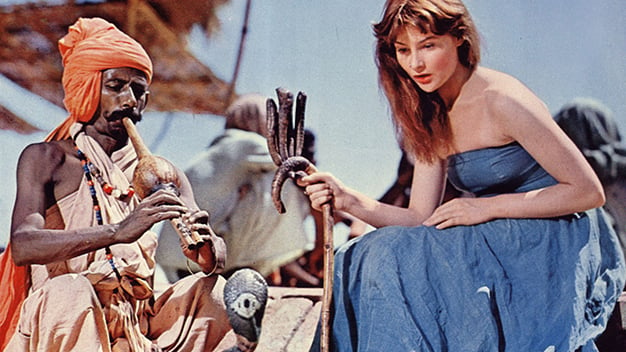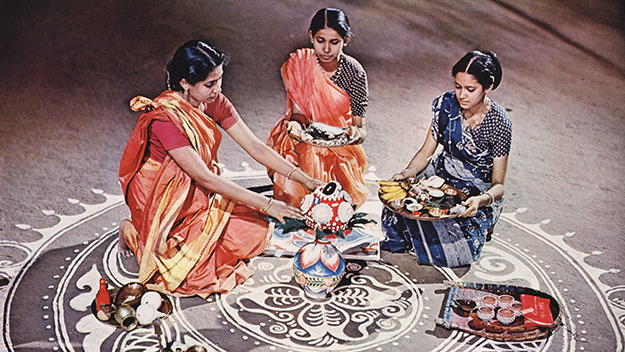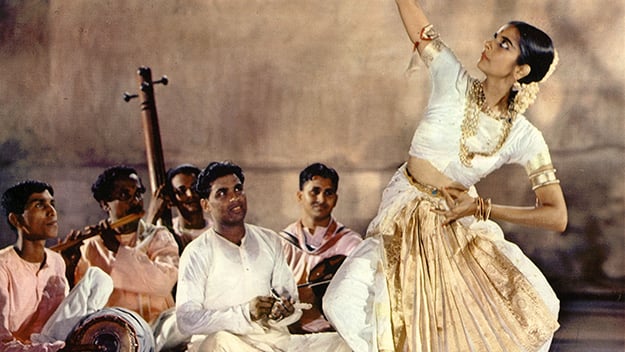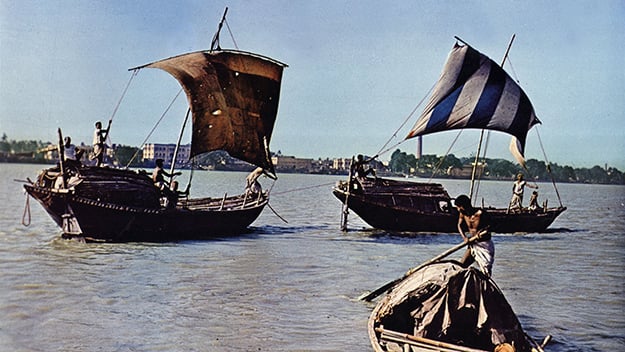Higher Learning: Renoir’s India
Higher Learning is a regular feature at Film Comment in which campus-based scholars share their work, bringing our readers into the rich and varied conversations occurring in the fields of film and moving-image studies.

Adrienne Corri in The River (Jean Renoir, 1951)
Published by the Duke University Press earlier this month, Where Histories Reside: India as Filmed Space by Priya Jaikumar examines eight decades of films shot on location in India to show how attending to filmed space reveals alternative timelines and histories of cinema. The following excerpt combines multiple sections from the book and has been edited and condensed for length.
“I went to India and I was convinced. The word convinced is weak. I was overwhelmed. It’s an extraordinary country, with extraordinary people, and I’ll tell you right away that it’s the least mysterious country in the world. For a Frenchman, India is very easy to understand.” –Jean Renoir, Renoir on Renoir
“India figures only as a setting, but more as a moral than a geographical setting. Its silent presence, to which the protagonists pay only half-conscious attention, acts on their minds as a magnetic field influences the needle of a compass.”–André Bazin, Jean Renoir
“We may all disagree with a work of art, and yet acknowledge it as great; as providing us with insights every time we approach it—even if it be removed from us in space, time, ideology, established knowledge and its structures, the ethics of our life and times.”–Kumar Shahani, “Film as Contemporary Art”
Like rivers, and like Renoir’s film that evokes a sense of liquid eternity, there is an endlessness to the stories that flow and ebb from The River’s location shoot in India between 1949 and 1951. The film’s slipstream of characters, images, and stories yields a history of how the West has related to the East, art to reality, objects to symbols, and people to places in the process of filming on location. To use Renoir’s preferred word, shooting in India “initiated” several significant events. By Renoir’s own admission, filming in India renewed his faith in humanity and his enthusiasm for filmmaking after difficult years of working with Hollywood studios. The River’s success at the Venice Film Festival (where in 1951 it shared the International Prize with Robert Bresson’s Diary of a Country Priest and Billy Wilder’s Ace in the Hole) marked the end of Renoir’s exile from Europe. European directors as different as Fritz Lang, James Ivory, and Louis Malle were enticed to consider India as a filming location because of the success of The River. The film introduced Technicolor to Renoir and to India and went on to influence how American directors Martin Scorsese and Wes Anderson would think about color and about the Indian subcontinent. Famously, Satyajit Ray met Renoir during this period, initiating a friendship that would give Ray the encouragement of a globally celebrated master to pursue his own creative vision in cinema. For his own productions, Ray would eventually partner with friends from The River’s crew, particularly art director Bansi Chandragupta, camera operator Ramananda Sen Gupta, and Subrata Mitra (uncredited in The River). Infamously, Renoir would recommend sound engineer Hari Dasgupta to Roberto Rossellini when the Italian filmmaker shot India Matri Bhumi (1959) in the country, setting the stage for Rossellini’s elopement with Dasgupta’s wife, Sonali.
The film’s afterlife is sustained by an equally scattered range of responses to it, from André Bazin’s defensive praise of the film, Ray’s disappointment over its neglect of Indian characters and realities, Kumar Shahani’s fleeting embarrassment on Renoir’s behalf, and Renoir’s own lasting attachment to India. Contemporaries questioned Renoir’s insistence that he would “rather abandon the idea” for the film than “shoot on sets in Hollywood” despite the inconveniences and ethical dilemmas of filming in a region immediately after its decolonization and bloody partition. As Satyajit Ray noted wryly, “I couldn’t help feeling that it was overdoing it a bit, coming all the way from California merely to get the topography right.”

The River (Jean Renoir, 1951)
The multiple registrations of India as location do not absolve The River of its orientalism, which is as evident on-screen as it is in off-screen remarks, such as in Renoir’s elaboration of “the Hindu soul” or in Bazin’s description of Bogey’s “little native friend” who is “as mysterious and taciturn as a bronze statue.” But the film crew’s experiences of shooting in India push us to discern the film’s rich discursive and material contexts while also opening up to the reciprocal influences and associations that were generated during the film’s production and pre-production process.
Differing from Ray’s criticism that there is not enough India in The River, some critics felt that there was too much of it. They felt that the story was “constantly interrupted by sumptuous excursions to the bazaars, by native dancing, by crowded river scenes” to distract the film away from its plot. Despite differences of opinion over India’s marginality or centrality to The River, accounts of the film’s production (and Renoir’s own accounts of the experience) indicate that visiting Bengal and traveling in India were pivotal experiences for the French director. Rumer Godden, who grew up in a household not unlike Harriet’s Big House in the East Pakistan (Bangladesh) region, found that “Jean came under the influence of India very, very much, and lost a little bit of the balance he should have had.” India’s influence on the director was both tactile and spiritual, mediated by new acquaintances and friends that Renoir and his wife, Dido, made during their sojourn to India. Renoir immersed himself in classical Hindustani and Carnatic music, attended Bharatanatyam and Kathakali dance performances, and after the film’s completion, stayed at the residence of Radha Sri Ram (Melanie in the film) in Adyar, Madras (now Chennai), eating home-cooked South Indian vegetarian food and marveling at its flavors.

The River (Jean Renoir, 1951)
After leaving France for the United States following the German occupation of France and the critical failure of Rules of the Game, the director found himself chafing under Hollywood’s system of stars and studio control. With The Southerner (1945), his first independently produced film in the United States, Renoir made a break from the studio system and avowed a preference for “adventurers” over “organization” in film finance. Kenneth McEldowney, eventually The River’s producer, was at this time a Beverly Hills florist and real estate agent in Los Angeles, California. On a dare from his wife, Melvina (the MGM publicist), McEldowney decided to produce a film to prove to her that he could improve on standard MGM fare. McEldowney tried to get an option on Rumer Godden’s novella, only to find that Renoir had already acquired it. This began a collaboration between a first-time producer and an acclaimed European filmmaker looking for avenues outside Hollywood.
Permission to shoot in India was contingent on 75 percent of the crew being Indian citizens, at a time when citizenship was a new experience for Indians. For Indian film technicians, crew, and craftsmen, this opened up a rare opportunity for below-the-line work on an international film. For Renoir, shooting in India opened up an opportunity to be free of Hollywood studio managers who were focused on the company’s bottom line and actively interfered in his directorial efforts. At the same time, filming in India raised obstacles of an entirely different nature for the filmmaker. India lacked the infrastructure to support large-scale foreign film productions at the time. Mobile electrical equipment, generators, and arc-light projectors had to be imported from Britain, and this equipment was delayed by the requisitioning of ships to Indochina. Even with the arrival of equipment, there was only enough power on-site to light up small areas, forcing Renoir to conceptualize the film in terms of static rather than mobile shots with the camera moving in and out of an image rather than laterally. In producer McEldowney’s words, “Taking a film company on location to India is something like doing a juggling act while walking a tightrope in high wind.”

The River (Jean Renoir, 1951)
The infrastructural problems that Renoir faced shooting in India were compounded by communal tensions in West Bengal. Not only did the film’s electrical department have to find ways to make their AC power plugs compatible with India’s DC sockets, they also had to figure out how a predominantly Muslim electrical crew could work on the grounds of Hindu property owners on whose land stood their two electrical generators. The presence of two million refugees in Calcutta, ongoing communal rioting, and a violent episode of students who stopped the film’s shoot because of rumored impropriety caused the crew to get police protection. The crew was also vulnerable to sickness,and Renoir’s nephew, Claude, the film’s cinematographer, contracted typhoid while in India. If India’s historical context is effaced at the level of film text, it was nevertheless a daily reality for the film’s production crew and well documented in the production files, providing grist for the publicity mills and confirming India’s hinterland status.
In terms of filmmaking, the lack of production facilities meant that at the end of a day’s filming, the footage was flown from Bengal to Britain to be developed at the London Technicolor office. Renoir and art director Eugène Lourié viewed the film’s rushes about ten days after the shoot with “some of the sequences lost or ruined,” and received cryptic telegrams about the quality of the color prints from Carl Koch in London. Given a lack of screening facilities and the monitoring of film content imported into India, Renoir and Lourié had to view the film’s rushes with the Calcutta customs officer who invited “his entire family . . . his wife, his children, his cousins and his aunt to a small screening room.” Unintentionally, this would have been the film’s first test audience. Indian voices are largely silent in the film, but we can conjure up a din of the unrecorded conversations in Bengali that must have taken place between this officer’s family members when the film’s rushes were screened.
India’s fiscal condition was also unstable after its independence. Whereas the Euro-American film crew benefited greatly from the country’s inexpensive labor and human resources, repeated devaluations of the Indian rupee led to revised contracts for the crew and constant rebudgeting for the producer. Additionally, Indians lacked Hollywood’s streamlined production practices and safety protocols. Lourié constructed a mock village on location because Renoir had some difficulties in finding the perfect village for his film. Real huts were fire hazards, and those situated by the river were surrounded by overgrown vegetation that was an obstruction to natural or artificial light sources. To Lourié’s surprise, Indian laborers accustomed to working with brick and teakwood rather than plastic and synthetic materials built a real village street rather than a simulation, blurring the line between reality and its simulation. While The River includes documentary shots and some actual locations, several places in the film were constructed sets rather than pre-existent sites. After Renoir left India, these sets were assimilated with the land as actual habitations for local populations. The fictionality of the film’s set was but a brief interregnum in the habits of life within a region that was not set up for film production.
Priya Jaikumar is Professor of Cinema and Media Studies at the University of Southern California’s School of Cinematic Arts in Los Angeles, where she teaches and writes about world cinema and film history. Her first book, Cinema at the End of Empire, explored film style and film policy during the decline of colonialism and rise of nationalism in Britain and India between the two World Wars.







